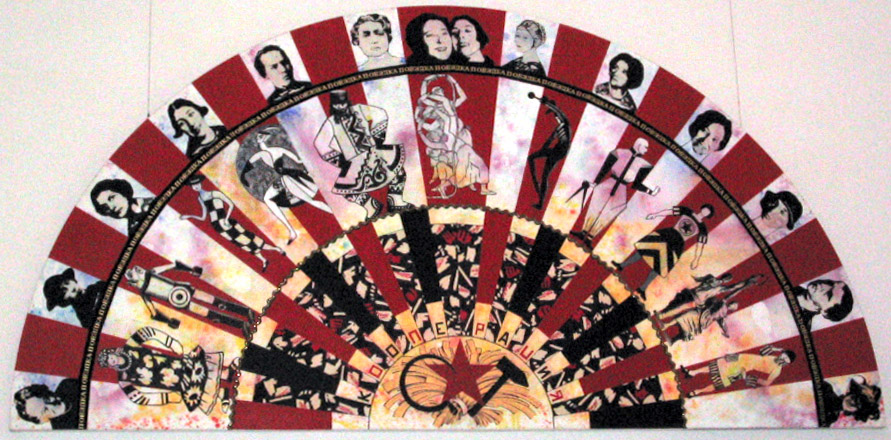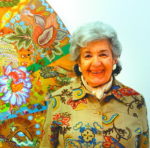
Miriam Schapiro
Canadian, 1923-2015 (active America)
Mother Russia, 1994
acrylic, mixed media, silk screen collage on canvas
72 x 144 in.
SBMA, Museum purchase with funds provided by the Twentieth Century Deaccessioning Fund and the Santa Barbara Visionaries: Lillian and Jon B. Lovelace, Karen and Matthew T. Yonnally, Jill and John Bishop Jr., Mercedes H. Eichholz and Zela and John Rex
1995.11

Miriam Schapiro, painter, sculptor, printmaker, and leader in the Feminist Art Movement. Photo source: Wikimedia.
A quote from Miriam Schapiro’s catalogue on her Collaborative Series:
"I’ve chosen to use fabric and the decorative arts as tangible symbols of my connection to domesticity and to express my belief that art resides in domesticity. For me the fabric of my art and the fabric of my life neatly equate each other."
RESEARCH PAPER
Description of work:
Mother Russia is a perfect example of a work from the Pattern and Decoration Movement. It is a semi-circular painting of major proportions that is read like a fan. It incorporates repetitious pattern and feminine decoration. The centerpiece of Miriam Schapiro’s most recent body of work called, Collaboration Series, it is a contemporary history painting of dynamic graphic design and imagination which pays homage to modern Russian women artists. Along the outer edge, the painting presents silkscreen portraits of the fourteen artists. On the far right is the artist’s self- portrait taken from the cover of her first one-person exhibition in 1971 which depicts her in Victorian dress. As a daughter of Russian immigrants, she identifies herself with these thirteen woman artists as predecessors. The second row consists of figural examples of each of the artist’s work. Separating these two rows is a fabric border woven with the repeated Cyrillic (Slavic alphabet) word for journey. The next field underneath is a vibrantly abstract design outlined with rick rack that recalls the artist’s earlier efforts in founding the Pattern and Decoration Movement. The alphabet is used again to spell out the Russian word for cooperation indicating that these women artists of the Russian revolutionary period worked together to create some of the most enduring work of modern times. At the center of the semi-circle created by the fan shape are symbols of the Russian revolution: sheaves of wheat, the red star, the hammer and sickle. The fact that they are portrayed separately rather than in the thttp://www.vietnamemorial.org/images/shapiro.jpgraditional grouping could be a comment on contemporary Russia. The colors are a vibrant red, black, white and pale yellow. There is a mottled spray of pale color over the white stripes of the fan that serve to consolidate the work.
The Pattern and Decoration Movement:
Patterning is a systematic repetition of motifs used to cover a surface in a decoratively uniform way. The intricate patterning of the fretwork of Islam’s metaphysical art and the interlacing of early Celtic designs are perfect examples of earlier uses. Matisse’s famous brilliantly colored cutouts are a more contemporary form of patterning. In the Pattern and Decoration Movement, two or more motifs are reiterated clearly and methodically over the surface of each work. They usually appear to be side by side in neat rows or tiers. When these design elements are repeated they make a pattern, thus the designation. Frequently these patterns were created with wallpaper or fabrics and were incorporated in the paintings along with the female decorative elements of beads, lace etc. In an expression of their sex, women artists began to incorporate needlework, embroidery, weaving , glitter, beads, lace, quilts and ornamentation of all kinds in their work. These artists rejected the cool hard-edged minimalism of the 1960’s and introduced a rich decorative abstract style. "For the first time in the history of Western Art, women were leading, not following a major art movement." (Art News , Oct. 1980) These women also broke down the elitist separation between high art and low craft as they incorporated craft techniques in their art forms, for example, Judy Chicago’s use of china painting in The Dinner Party. Miriam Schapiro through the deliberate expression of femininity and use of pattern in her work was instrumental in developing this movement.
Biography:
Miriam Schapiro began her career as an abstract painter in New York in the 1950’s after graduating from the University of Iowa with a Masters of Fine Art in 1949. At first she found it difficult to come to terms with the direction her art would take because of the lack of women role models. Although she had made the decision to be an artist early in life, she became disillusioned when she never read of a woman artist of the stature or Vermeer or Velazquez. She felt men’s concerns informed most art and therefore finding her place in the contemporary art scene in New York proved to be very challenging. She and her husband, Paul Brach, who was also an artist and fellow graduate of the University of Iowa, would attend artistic gatherings and clubs, but she felt like an outsider. Lacking a sense of camaraderie with the men, she found no kindred spirits either among the women regarding her notions about painting. Nevertheless, she became very familiar with the art scene in the city, artists working in large lofts, with naked light bulbs, spending every dime on material and every working moment on producing something new.
In 1970 her sense of isolation changed dramatically when she joined the staff of Cal Arts in Valencia, CA. She discovered serious women artists who worked in a very different atmosphere. They had no money for good paper or canvas so they made do with paper or board, often on dining room tables, comparing notes about raising children. These women were unlike any artists she had ever known or imagined and she felt empowered by them.
Schapiro was invited to guest lecture in Judy Chicago’s feminist art class in Fresno, CA and in turn asked Chicago to help her start a Feminist Art Program at Cal Arts. In trying to meet her goal she became aware of the conflicts and problems of sexist attitudes. In spite of the difficulties, in starting the program, she, her students and friends initiated a major project called Womanhouse (1972). Joined by Chicago and other women artist friends, they converted an old abandoned mansion in Hollywood into an exclusively female environment filled with art works and live performances, which fulfilled all of their dreams and fantasies.
Returning to her own work following this experiment, Schapiro entered a very productive period. Her work was now informed by the work of other women artists and she no longer felt isolated. She began incorporating pieces of fabric, embroidery, handkerchiefs etc. into her work, affirming her sense of comradeship with women through the centuries who had made art through handicraft. When she tried to find reproductions of the work of women artists for her Collaboration Series, she discovered only a few by Mary Cassat and Berte Morisot. Outraged that art history was excluding women artists from textbooks and reproductions, she started a publication, called Heresies , to examine the relationship between art and society.
Schapiro has lectured widely, served on the governing board of the Woman’s Caucus for Art and on the board of the College Art Association. She founded the Feminist Art Institute in New York. Her recent large scale works, such as her Collaboration series are referred to as femmages, a contraction of the French words femme and hommage. These works incorporate painted patterns and decoration that infuses the art with sensuousness born of the feelings of joy and harmony in being a woman and a woman artist. With these works she has earned a place in art history by closing the gap between fine arts and domestic crafts thereby validating long degraded "woman’s work" by incorporating its materials and method into the ranks of high modernism.
Bibliography:
Rubenstein, C. American Women Artists 1982
Wheeler, Art Since Mid-Century 1945 to Present 1991
Balken, Exhibition Catalogue-Miriam Schapiro 1975
Aktwell, Bongard’s Newsletter 1978
Schapiro, Miriam Collaboration Series catalog Steinbaum Krauss Gallery 1994
Prepared for the SBMA Docent Council by Jean Reese, 1997
Revised by Gay Collins, 2003
SBMA CURATORIAL LABELS
Miriam Schapiro pairs portraits of Soviet women with their artwork—fashion designs of artists such as Varvara Stepanova (Russian, 1894-1958) and Lyubov Popova (Russian, 1889-1924), among others. Schapiro, herself a daughter of Russian immigrants, appears at the bottom right, in a Victorian costume by Nancy Youdelman (American, b. 1948). The two Russian words поездка (“journey”) and кооперация (“cooperation”) allude to the collective socialist and feminist struggle of women artists to realize the socialist society of the future—one in which the sexes enjoy equal rights. By assembling examples from the field of textile and fashion design, Schapiro surely pays homage to not only this earlier generation of women pioneers but also traditional techniques of production often associated with women.
- Park Projects, 2020
